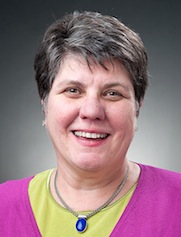Patricia Flatley Brennan Q & A
Q: Tell us something about the National Library of Medicine. What is it, who are its constituents, and why does it matter?
A: The National Library of Medicine (NLM) is the largest collection of biomedical knowledge in the world. It includes paper books and journals, and electronic resources ranging from gene databanks to online journals. The NLM is both a research institution and a major service provider. Its research contributions include sophisticated strategies to locate, label and display on computer systems worldwide all sorts of health information, from a gene sequence to a research report to the images that reveal nanostructure within cancer tumors. The NLM maintains the archives of health, including historic manuscripts, transcripts of Native American healing practices, and more than 70,000 digitized images of significant photographs, prints and public service announcements.

Patricia Flatley Brennan
NLM serves the information needs of the public, of public policy and clinical practitioners worldwide, scientists in universities and research centers, and the more than 5,000 scientists at the National Institutes of Health. While the primary constituency is people, increasingly computers are the biggest users of NLM resources. The people range from world-class research teams at major universities to ordinary citizens looking to understand health problems. Computer-to-computer uses help in drug discovery, determining the location and meaning of a genetic anomaly, and assist public health professionals in determining the exact nature of infectious diseases and food contamination.
Q: What are the biggest challenges facing the library?
A: Some of the challenges facing the library are very easy to see and understand, such as making sure that the information needed for scientific discovery and clinical care are available at the point of need. Others are less apparent, such as ensuring that the ways knowledge is structured and indexed reflects contemporary understanding of health and illness. The NLM is well resourced, yet continuing to provide the quality of service as the point of need will require setting priorities on investment, development and infrastructure stabilization.
Q: What do you aspire to accomplish as the library’s new director?
A: I will lead the biomedical and information science communities to develop a strategic plan that will launch the NLM’s third century. Important pillars of the plan will be leveraging big data and data science for health, ensuring the quality and adequacy of the biomedical informatics workforce, expanding the definition of health information to encompass the social and behavioral domains, and creating the information and information management tools to help scientists and the public glean the benefits from the president’s Precision Medicine Initiative.
Q: We live in the most information-rich age in the history of the world. In that context, how do you view the role of libraries, in general, and the role of the Library of Medicine in particular?
A: The NLM is and will continue to be a national treasure charged to locate, organize and disseminate information for health. Advances in discovery (what is known) complement advances in digital systems (how what is known is made available to interested users). We are entering a time in which the speed of discovery is outpacing human capacity to read and organize information. The NLM will devise and distribute new information management and synthesis tools — like machine learning and artificial intelligence-driven systems — to augment and sharpen human judgment, enable wisdom, and support healthful action.
